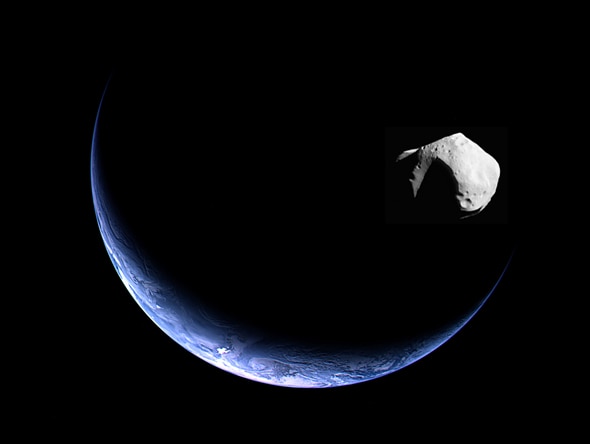Create a free profile to get unlimited access to exclusive videos, sweepstakes, and more!
A Small Asteroid Will Definitely Miss Earth on March 5. But by How Much?

In the “don’t panic” category, the small(ish) asteroid 2013 TX68 will definitely miss the Earth when it swings by our fair world on March 5.
The orbital mechanics on this are pretty clear; it certainly won’t hit us. The thing is, it’s not clear by how much it’ll miss us, and the range is a bit uncertain: It’ll pass somewhere between 17,000 to 14 million kilometers from Earth.
Yeah. That’s a big gray area. So what gives?
TX68 is a rock roughly 30 meters across*, and that’s pretty small as these things go. That means that at any respectable distance from Earth it’s essentially invisible; too faint to detect. We can only see it when it gets close enough to Earth to be visible to telescopes, and that window of opportunity doesn’t last long.
It was discovered in October 2013 when it was about 1.5 million kilometers away (nearly four times farther than the Moon) and was only observed over a three-day span before it became too difficult to see. That makes getting an accurate orbit for TX68 really hard. I’ve written about this before:
Think of it this way. Imagine you’re an outfielder in a baseball game. You see the pitcher throw the ball, and the batter swings. It’s a hit! But one-tenth of a second after the batter makes contact, you close your eyes.
Now, based on the fraction of a second you saw the ball move, can you catch it?
I would be willing to bet a lot of money you won’t. You weren’t able to watch the ball long enough to get a good fix on its direction, its speed, its position. It could land next to you, or it could fall 40 meters away, or it could be knocked right out of the park.
The only way to catch it would be to keep your eyes on it, observe it as long as possible until you can be completely sure of where its headed.
That’s the problem; with only three days of observations of TX68 back in 2013, it’s impossible to predict exactly where it will be when it passes the Earth in March. What you get is a fuzzy prediction that puts it near the Earth, with a range of likely distances based on that. The closest it can get is 17,000 kilometers, but it could pass us 14 million kilometers away.
From a position of “Ohmygod is this thing gonna hit us?” we’re pretty safe. From an astronomer’s position of “Hey I want to observe this thing for myself and help nail down its orbit” it’s frustrating. That uncertainty means we’re not even really sure where it’ll be in the sky at a given time. Our best bet is to use wide-field telescopes, scan the most likely areas it’ll appear, and hope for the best.
And I hope the best is what we get. TX68 is a near-Earth asteroid, passing pretty close to us; it could impact us in the future. As it stands right now the odds are extremely low for the next few decades … but that’s based on the orbit as we know it now. After this pass we should increase our understanding of the orbit substantially.
To be honest, that won’t be easy. If it does pass only a few tens of thousands of kilometers away, the Earth’s gravity will change its orbit (it also may pass within 20,000 kilometers of the Moon, further altering the asteroid’s orbit), making it even harder to predict its future position.
All of this underscores our need to have more eyes on the sky. An impact from a TX68-sized asteroid is pretty rare; statistically speaking it only happens every few centuries. But smaller rocks are more common, and impacts from them more frequent; the Chelyabinsk event of 2013 was caused by a rock a mere 19 meters across and impacts from something that size happen on the every-few-decades timescale. The more ‘scopes we have scanning the skies, the more likely we’ll be able to see such a rock in advance, and the more time we’ll have to do something about it… assuming we get around to figuring out just what to do.
* Correction, Feb. 9, 2016: I originally wrote that TX68 was 100 meters across; it's actually 100 feet or 30 meters across (the error is my fault, but oh how I wish everyone used metric!). That changes the statistical frequency of impact from millennia to centuries.














